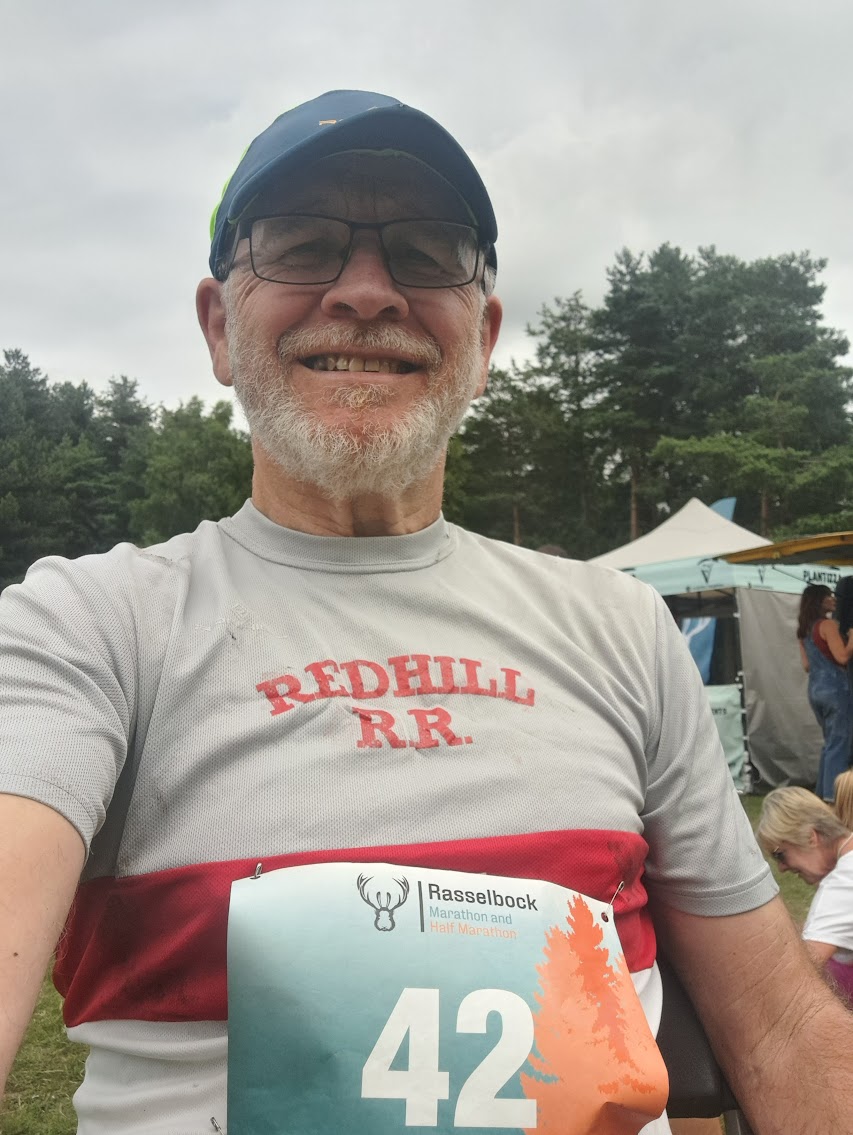Today, I participated in Rasselbock’s off-road marathon in Sherwood Pines (a nearby forest just south of the more famous Sherwood Forest). I am not currently training for marathons; my focus is on the Spine Race in January 2025 (a 268-mile / 440 km race carrying a relatively heavy bag). So, I was not sure how the run would go. At the start of the race, I was in two minds about whether to start with the 4-hour pacer or the 4.5-hour paces. I run road marathons in under 4 hours, but forest tracks are slower than road races.
In the end, I decided to give the 4-hour option a try, my plan A. The course is a two-lap route, and the first half-marathon went pretty well. I completed it in 1 hour and 54 minutes. However, towards the end of the first lap, I could tell that I would not be able to run the second lap at that pace, so I moved to my Plan B. Plan B was to run the second half-marathon just fast enough to finish under 4 hours. This meant averaging 6 minutes per kilometre on the second lap (on the first lap, I averaged 5 minutes 31 seconds per km). This seemed OK for a while, but at about 32 km I was becoming aware that I would not be able to hold this pace until the end. As I started to think about Plan C, I suddenly developed a cramp in my left leg. This meant stopping for a couple of minutes, stretching my leg and using my muscles to pull my toes back as much as possible. Followed by a few minutes of stiff-legged walking until the cramp had subsided. My Plan C was now to run at the sort of speed I do ultra races (between 8 and 9 minutes per km) to ensure that I was able to finish, able to run, and avoid any more cramping.
I finished in 4 hours 16 minutes, and on the drive home I had time to think about my learnings from this event. This meant I completed the first half-marathon in 1hr 54 and the second half-marathon in 2 hours 22 minutes.
When I train for marathons and get my pace right, I tend to run the second half slightly faster than the first half, something we call a negative split. This did not happen today, and it did not happen because I chose the wrong starting pace. However, there is much more than that to learn from the run, IMHO.
If I had started with the 4.5-hour pacer, I would probably have run the marathon in about the same time, but I would have run the second half faster than the first half. I would probably not have had cramp, and it would have been a more comfortable day.
However, because I have not run this distance recently, because I am not currently training for marathons, I cannot be surprised that before the race starts, I will sometimes get my guess about what pace I can run today wrong.
Accepting mistakes, learning from mistakes, not beating yourself up about them, and not being afraid to make mistakes. I think these four points are key lessons for running, work, and life. Yes, as it turned out, I started too fast. In my next run (a fell race next weekend) I will start a little slower and monitor how I feel a bit more closely. However, I am not going to worry about today, I am not going to wish I started slower, I am not going to criticise myself for not starting slower. I am not going to be afraid to try hard races; I am not going to avoid trying to run faster or further because although I want to hit my goals, I know that sometimes I will miss them.
I am a big believer in having a plan, but I think it is important to know when to change plans. Too often, we see cases where people seem to think a Plan B is ‘do Plan A harder’. We see it in sport, politics, work and life in general. Today I started with Plan A, switched to my Plan B, and when that was not working switched to my Plan C. This meant I did not let events control me; I made a conscious decision about how I was going to respond to events. Having an internal locus of control is important to me.
I am also not going to say I am disappointed with my result or describe it as slow. Most runners know that unless you are a world champion, there are people who would love to run as fast as your worst run, there are people whose worst run is better than your best run, and there are millions of people who would like to be able to run at all.
Finally, I have a few thoughts about the event. This was the first marathon that Rasselbock have organised in Sherwood Pines, but they have a great range of shorter and longer events. This event was well organised, and I would recommend it. Today, there was a half marathon and a full marathon. There was a ‘village’ at the start, with plenty of attractions, and between the village and Sherwood Pines there was masses of things to do for non-running family and friends. One of the items in the village that caught my eye was a fire engine that had been converted into a bar. Trail races tend to be much less pressured and precious than road races.



